|
Notice: This page contains information for the legacy Phidget21 Library. Phidget21 is out of support. Bugfixes may be considered on a case by case basis. Phidget21 does not support VINT Phidgets, or new USB Phidgets released after 2020. We maintain a selection of legacy devices for sale that are supported in Phidget21. We recommend that new projects be developed against the Phidget22 Library.
|
OS - Windows
![]() On Windows, Phidgets can be either plugged directly into a USB Port or run over a network using the WebService.
On Windows, Phidgets can be either plugged directly into a USB Port or run over a network using the WebService.
Phidgets are designed to run on Windows 2000 or newer, on both 32 and 64-bit systems.
Getting Started (Libraries and Drivers)
If this is your first Phidget, we highly recommend working through the Getting Started guide for your specific Phidget device. If you already have the ![]() icon in your task bar and know how to use it, then you've already followed the guide and are ready to learn more about the control panel, the Phidget WebService, and more - all specific to Windows.
icon in your task bar and know how to use it, then you've already followed the guide and are ready to learn more about the control panel, the Phidget WebService, and more - all specific to Windows.
If you are already a pro, and just want the drivers:
For special cases where you want to install the Phidget libraries without the installer, please see the Advanced Uses section.
- Phidget21 Libraries (32-Bit and 64-Bit development files without an installer)
- Software License
Installing
The Phidget installer requires that your system has .NET framework 2.0 or higher. The .NET framework can be downloaded from Microsoft. If you do not have the .NET framework 2.0 or later installed, you can still use Phidgets. However, you won't be able to use the installer, and will have to manually install the Phidget libraries. Please see the Advanced Uses section.
To install the libraries, follow these steps:
1. Download one of the Phidget installer for your system, depending on whether your system is 32 or 64-bit.
2. Open up the installer, and proceed through the wizard.
Please note that by default, the installer places the Phidget libraries in C:\Program Files\Phidgets.
3. Once the installation is complete, you are ready to program with Phidgets. To find out what files got installed, please see Description of Installer files in the Appendix section.
Next, the Phidget Control Panel will be discussed.
Phidget Control Panel
The Phidget Control Panel is a tool to quickly determine whether your system is able to communicate Phidgets, and also act as a debugging tool.
Once the Phidget libraries are installed using the installer, you should see the ![]() icon in the taskbar. Double click on it to bring up the Phidget Control Panel. If the icon does not appear, just find and open the Phidget Control Panel from the start menu.
icon in the taskbar. Double click on it to bring up the Phidget Control Panel. If the icon does not appear, just find and open the Phidget Control Panel from the start menu.
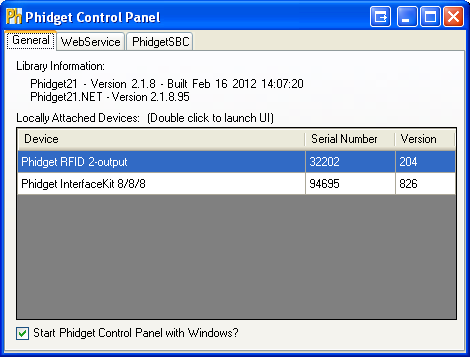
The general tab shows the list of Phidgets currently physically attached to the computer. You can also view the currently installed Phidget library version, as well as having the checkbox option to choose whether the Phidget Control Panel is to be started up automatically once Windows boots up. You can double click on a Phidget device in the Phidget Control Panel to open up an example program for the device.

In the above screenshot, the RFID example was opened. These examples are intended for demonstration and debugging purposes. If you have not yet already, please see the Getting Started guide for your device. It is important to keep in mind that when an example Phidget application is opened from the Phidget Control Panel or opened from any of your Phidget applications that you develop, it holds a lock on the Phidget. This prevents any other program from accessing the Phidget. Please ensure that this example application is closed(the Phidget Control Panel can still be running) when you are running your own applications.
The next tab is the WebService tab, which allows you to control Phidgets over a network. There are four sub-tabs. The first sub-tab is the Setup tab.
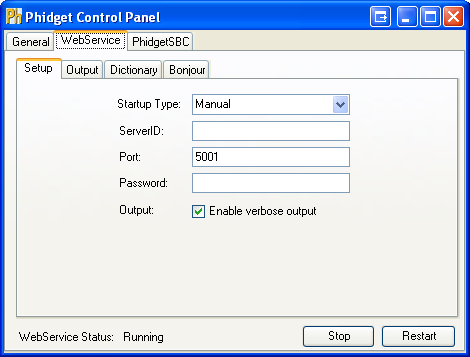
Here, you can start and stop the WebService. Details are provided in the WebService section. You can also determine whether the Phidget WebService is currently running. There is also a check box that you can select to turn on verbose output, which will display useful troubleshooting information for the WebService.
The next sub-tab is the Output tab, which provides useful debugging information while you are using the WebService. This tab will only show up if the verbose output option is selected in the previous tab.
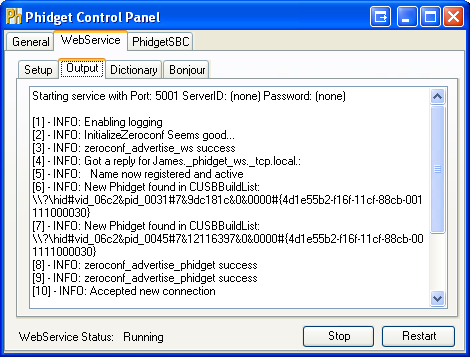
The Dictionary sub-tab comes next; it lists all the key-value pairs that gets created when the WebService runs. More information is provided in the Dictionary section of the General Phidget Programming page.
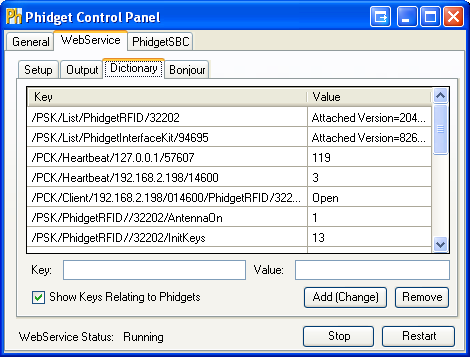
The Bonjour sub-tab gives a list of all currently attached Phidgets that are connected to the WebService. This tab will only appear if you have Bonjour installed onto your system. You can also double click on the Phidget to connect to it over the network using one or more computers, but still use the Phidget on the computer it is directly connected to.

The last tab is the PhidgetSBC tab, which displays the complete list of PhidgetSBCs connected to the network. This tab will be enabled if you have Bonjour installed onto your system.
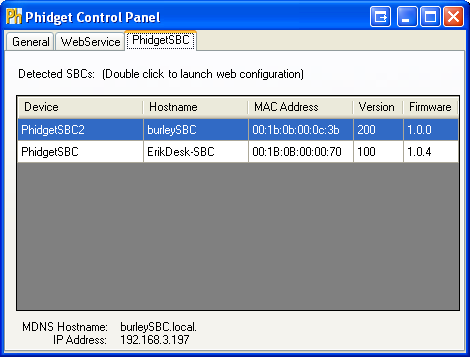
You can double click on the PhidgetSBC to bring up the PhidgetSBC Administration Console log-in page in your default browser.
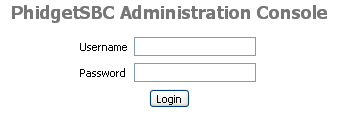
The PhidgetSBC Administration Console is where you can go to configure the PhidgetSBC. For more details, please see the PhidgetSBC section.
Checking
To confirm the libraries were installed and work correctly, you can check both the hardware and software components of the interface. It is worth checking the software side first, because if it works then you know the hardware side is also okay.
Software
If you have the Phidgets library installed on your system, you can verify that the software side component is working by seeing if a Phidget device is listed in the General tab of the Phidget Control Panel.

The above screenshot shows that a PhidgetRFID and a PhidgetInterfaceKit are attached to the computer. If you see your Phidget in the list, you can continue to the programming languages section to learn more. If you are not able to see that the Phidget is in the list, there may be a hardware issue. Please see the hardware section for more details.
Hardware
You can verify that your computer detects that the Phidget is plugged in through a USB connection by going to the Windows Device Manager.
On Windows XP, you can access the Device Manager by right clicking on My Computer, and selecting Device Manager under the Hardware tab. The Device Manager window will open.
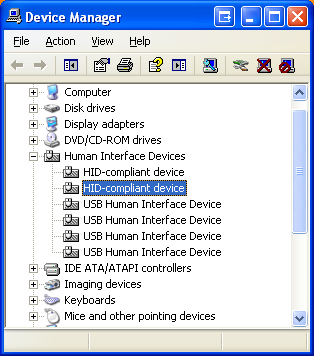
Under the Human Interface Devices heading, you can view whether your computer detects that the Phidget is connected through the USB if it is in the list. There should be a HID-compliant device and a USB Human Interface Device entry for every Phidget that is attached to the computer. Please note that there is currently no way of directly determining which entry belongs to which Phidget. A simple way of verifying which entry belongs to which Phidget is to simply connect or disconnect the Phidget from the USB port of the computer. The list will automatically refresh to show the updated list of all connected USB devices.
If you don't see the Phidget in the list, then take a look at the troubleshooting section below, as well as the Communications section of our general troubleshooting page.
Troubleshooting
If the examples do not work but USB does work (i.e. your computer can consistently see the device in the hardware), take a moment to check the basics:
- You are using Windows 2000 or newer.
- The Phidget Control Panel requires that you have .NET framework 2.0 or newer.
- No other programs, drivers, or processes are using that USB port in software. Some drivers or software will sometimes mistakenly claim Phidget devices when waiting on some hardware to be connected. Please see the section: third party software prevents communications with Phidgets for more information.
- The Phidget libraries are the latest version (visit the getting started section to download them)
- Check the common problems section below, some specific combinations can cause problems
If your problem doesn't seem to be fixed by these steps, make sure that the Phidget is seen consistently by USB (if it is erratic, try our general troubleshooting guide). If you are still having problems after using the troubleshooting guide, please ask us!
Programming Languages
Phidgets’ philosophy is that you do not have to be an electrical engineer in order to do projects that use devices like sensors, motors, motor controllers, and interface boards. All you need to know is how to program.
After you have installed the drivers above, you should pick a programming language, install libraries, and run the examples for that specific language. You can learn more about what is needed to program in a particular language by choosing the language of your preference below. If you need help choosing a language, please look at the language comparison table.
On Windows, we recommend the following languages:
You can also use these languages, but they do not support event driven code, and must use logic code only:
The following languages are also supported, but due to a lack of demand, the full API is not implemented. Please refer to the specific language for more information on what features are unsupported.
WebService
The Phidget WebService allows you to remotely control a Phidget over a network. For more information, please see the Phidget WebService page.
Drivers for the Phidget WebService on Windows are already included in the Drivers above. If you have a ![]() icon in your taskbar, you already have the WebService drivers installed.
icon in your taskbar, you already have the WebService drivers installed.
There are two ways that you can connect to a Phidget hosted on another computer. The first method is by using the IP address/host name and port of the host computer. The second method makes the use of mDNS, which allows Phidgets to be found and opened on the network by a server id instead of an IP address/host name. When using a server id, both the client and server will need to be running an implementation of zero configuration networking. The Phidget WebService takes advantage of the Bonjour software. It is a tool, developed by Apple to locate devices such as Phidgets, and printers. It allows you to connect to a Phidget over the WebService while specifying the server id. You will have to install Bonjour onto your system to use the second method.
This section helps you install, check, and use the WebService on Windows, but we also have an overview of the Phidget WebService in general.
Turning the WebService On and Off
There are two methods that can be used to turn the WebService on and off. The first method is through the Phidget Control Panel. In the WebService tab, you can start, restart or stop the WebService. You can also choose to have the WebService start up automatically upon Windows boot up by selecting Automatic as the Startup Type. By leaving the Startup Type as Manual, you will have to manually turn the WebService on everytime you wish to use it.
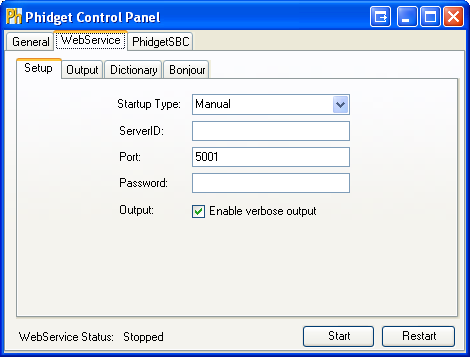
The second method of turning the WebService on and off is through command line. If you used our installer, the WebService utility is automatically installed in C:\Program Files\Phidgets\PhidgetWebservice21.exe. Otherwise, if you wish to manually install the PhidgetWebservice21.exe, you can place it anywhere on your system, and navigate to it in command line.
You can get command line help with PhidgetWebservice21.exe using the -h option:
PhidgetWebservice21 -h
'phidgetwebservice21' is a Phidget and Dictionary server from Phidgets Inc. See www.phidgets.com for more information.
Usage: phidgetwebservice21 [OPTION]
All parameters are optional. The default parameters are: port=5001, ServerName=(Computer Name) and no password
Options:
-p Port
-n Server Name
-P Password
-v Debug mode
-h Display this help
Mapping out which command line options to which Phidget Control Panel option is as follows:
-p: Port field
-n: ServerID field
-P: Password field
-v: Enable verbose output checkbox
To find the host name and IP address of your computer, open up the command line prompt.
- For the default server name, type
hostname. - For your IP address, type
ipconfig -all.- A line in the return text, will say something like
192.168.2.198, which is your IP.
- A line in the return text, will say something like
Here are some usage exampless. The Windows command line is used. Traverse to the Phidget installation directory(by default, it is located in C:\Program Files\Phidgets).
To start the WebService with default parameters:
PhidgetWebservice21.exe
To start the WebService with a server name of myServer:
PhidgetWebservice21.exe -n myServer
To stop the WebService, simply close the command line window or press Ctrl and c at the same time in the command line window.
Using the WebService
To use a Phidget over the WebService, you'll want to:
- Have two different computers connected to the same network. We will call the computer that has the Phidget directly connected to the USB port the host. The client will be the computer that runs a Phidget application to connect to the Phidget attached to the host. Please note that if you only have a single computer, you can also connect to the Phidget over the WebService. The computer will simply act as both a host and client. This will allow you to bypass the one application per Phidget limitation.
- Start the WebService on the computer that directly connects to the Phidget
- Run your program on the remote computer that will control the Phidget over the network
The easiest way to test these steps on Windows is download and install Bonjour onto both the host and client. Next, we will set up the WebService and run the Phidget program on the client. Please follow these steps:
1. On the host, open up the Phidget Control Panel and traverse to the Setup tab of the WebService section.

2. Leave all fields the way they are, and click on Start to run the WebService.
3. You can determine that the WebService is running by looking at the WebService status at the bottom of the window.

4. Ensure that the Phidget is plugged in to the host.
5. On the client's Phidget Control Panel, open up the Bonjour tab in the WebService section. You will see the Phidget that is plugged into the host as one of the entries listed. Double click it to open the example application.
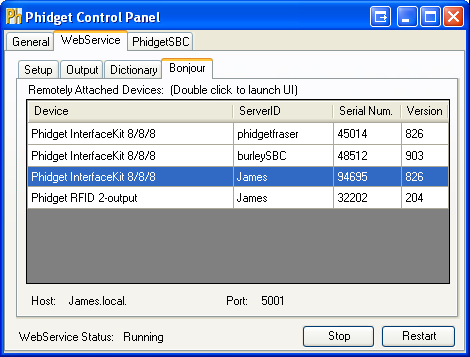
6. The example application will open up, and you will be able to communicate with the Phidget over the WebService.

7. You can confirm that the WebService was indeed behind this exchange by terminating the WebService process while still allowing the remote program to run. On the host's Phidget Control Panel, traverse to the Setup tab of the WebService section. Hit Stop to terminate the WebService.

8. Take a look at the example application on the client. Since the application can no longer connect to the WebService, the attached state of the Phidget is false.

Debugging the WebService
In addition to enabling logging in your Phidget code, you can get additional debugging information from the WebService itself. This additional debugging can be enabled from the Enable verbose output checkbox in the Phidget Control Panel.

The debugging information is shown in the Output tab.
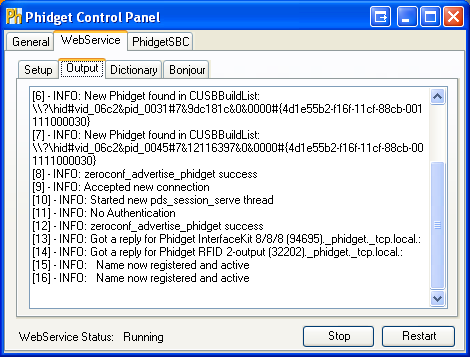
If you are using the command line approach to start the WebService, debug information is enabled by specifying the -v option:
PhidgetWebservice21.exe -v -n "myServer"
The debugging information is shown command line output. This will prove useful when debugging WebService problems.
Advanced Uses
Manual File Installation
The Phidget installer installs the most commonly used files onto your system. However, there may be special cases where you want to install the Phidget libraries without the installers. This section will describe the purpose of the most important files file and cover how to manually install and distribute the libraries with your code. You can get the files here.
Description of Library files
phidget21.dllcontains the actual Phidget library, which is used at run-time. It is placed inC:\Windows\System32.PhidgetWebService21.exeis used to control Phidgets remotely across a network using the PhidgetWebservce.phidget21.libis used by your compiler to link to the dll. Your compiler has to know where this file is, by default our installer putsphidget21.libintoC:\Program Files\Phidgets, so you can either point your compiler to that location, or copy and link to it in a directory for your project workspace.phidget21.libis written to be compatible with most compilers - but your specific compiler may need a different format. Check our documentation for your specific compiler for details. Please note that we provide versions of thephidget21.libthat are specifically optimized for 32-bit or 64-bit systems. If you are using a 64 bit versions of Windows, thephidget21.libis placed inC:\Program Files\Phidgets; The 32 bit version ofphidget21.libis placed inC:\Program Files\Phidgets\x86.phidget21.hlists all the Phidget API function calls available to your code. Your compiler also has to know where this file is. By default, our installer putsphidget21.hintoC:\Program Files\Phidgetsso you can either point your compiler to that location, or copy and link to it in a directory for your project workspace.Phidget21.NET.dllis the Phidgets library for .NET framework 2.0 or greater. Any .NET language can be used, including C# , and Visual Basic .NET.Phidget21.NET1.1.dllis the Phidgets library for .NET framework 1.1. Any .NET language can be used, including C# , and Visual Basic .NET.Phidget21COM.dllis the Component Object Model(COM) library and provides your project access to the Phidget ActiveX objects. This libraries is used by the AdobeDirector, AutoIT, Delphi, Visual Basic 6.0, Visual Basic for Applications, Visual Basic Script.
Special Cases of Library Install
Regardless of what language you will be using to program Phidgets, you will need the phidget21.dll placed in the C:\WINDOWS\system32 directory. Additional files are needed for the language that you choose. Please refer to the documentation provided by your language to determine what files are needed and the steps needed to install them onto your system.
You can find the phidget21.dll in the link below:
- Phidget21 Libraries (32-Bit and 64-Bit development files without an installer)
PhidgetWebService21.exe is also provided in the link above.
Windows in a Virtual Machine
Phidgets can also be used inside a virtual machine. Instructions for VMWare and VirtualBox are provided below. Virtual PC is not supported as USB Phidgets requires a virtual platform that supports HID USB Devices and since Virtual PC does not support HID USB devices, Phidgets may not be used.
As always, please ensure that you have the latest Phidget drivers installed on the virtual machine and that you are using the latest version of your virtual software.
VMWare:
To enable USB Phidgets, select Virtual Machine -> Removable Devices -> and select the Phidget Input Device -> Connect.
VirtualBox
To enable USB Phidgets, VirtualBox Guest Additions(Devices -> Install Guest Additions) may need to be installed. Afterwards, click on Devices -> USB Devices and select the Phidget device to enable. The state should go from Busy to Captured. VirtualBox may bring up a new hardware wizard in the host operating system, which has to be installed. Please note that Phidgets with USB hubs(i.e, 1019), are undetectable; Fortunately, Phidgets that are attached to such Phidgets are detectable.
Common Problems and Solutions
Issue: A corrupt installation fails on uninstall or repair
Affected Operating Systems: Windows
Solution: If the normal uninstall fails, or for whatever reason, you can choose to remove the Phidget drivers manually. Please perform the following:
- Shut down any programs using the Phidget libraries, including the WebService and the Phidget Control Panel.
- Delete
C:\Program Files\Phidgets\ - Remove the Phidgets key from the Registry
[-HKEY_LOCAL_MACHINE\SYSTEM\CurrentControlSet\Services PhidgetWebService21].
In most cases this is enough to get the installer working again. If you need to remove all traces of the Phidgets libraries manually, perform the following additional steps:
- Unregister the COM library:
regsvr32 /u "C:\Program Files\Phidgets\Phidget21COM.dll". - Remove
Phidget21.NETandPolicy.2.1.Phidget21.NETfromC:\Windows\Assembly\. - Delete
C:\Documents and Settings\All Users\Application Data\Phidgetsif you are using WindowsXP orC:\Users\All Users\Phidgetsif you are using Windows Vista. - Delete
C:\Windows\system32\phidget21.dll. - Delete Phidgets from the start menu.
- Search for and remove keys mentioning Phidgets from the registry in the following locations:
[HKEY_LOCAL_MACHINE\SOFTWARE\Microsoft\Windows\CurrentVersion\Uninstall\][HKEY_LOCAL_MACHINE\SOFTWARE\Classes\Installer\Products\][HKEY_LOCAL_MACHINE\SOFTWARE\Microsoft\.NETFramework\AssemblyFolders\Phidgets Inc][HKEY_CURRENT_USER\Software\Microsoft\Windows\CurrentVersion\Run\Phidget21Manager][HKEY_LOCAL_MACHINE\SOFTWARE\Classes\Installer\Assemblies\Global\]
- 7. Reboot
NOTE: You can go through the registry and purge any other keys mentioning Phidgets if you still have problems, but at this point you should be able to reinstall under most cases. There will also be keys relating to the installer, the .NET library and the COM library, but they should not interfere with anything.
Issue: Event data is sporadic/slow/clumped over the WebService
Affected Operating Systems: Windows
Windows implements 200ms delayed ACKs for network traffic. When traffic is one-way only - as it is with event data, the data will all arrive in clumps every 200ms because of delayed ACKs.
This can be a great drawback for applications which rely on low latency event data over the network. (source: http://support.microsoft.com/kb/214397)
This delayed ACK behavior can be disabled in windows to decrease event latency as documented here: http://support.microsoft.com/kb/328890
In the future, the Phidgets library may implement this differently, but so far we have been unable to match the performance achieved by disabling delayed ACK.
Appendix
Description of Installer files
Here is the list of files and their description for each file the installer puts onto your system.
phidget21.dllcontains the actual Phidget library, which is used at run-time. It is also placed inC:\Windows\System32.PhidgetWebService21.exeis used to control Phidgets remotely across a network using the PhidgetWebservce.PhidgetWindowsService21.exeis a Windows service that controlsPhidgetWebService21.exe.phidget21.libis used by your compiler to link to the dll. Your compiler has to know where this file is, by default our installer putsphidget21.libintoC:\Program Files\Phidgets, so you can either point your compiler to that location, or copy and link to it in a directory for your project workspace.phidget21.libis written to be compatible with most compilers - but your specific compiler may need a different format. Check our documentation for your specific compiler for details. Please note that we provide versions of thephidget21.libthat are specifically optimized for 32-bit or 64-bit systems. If you are using a 64 bit versions of Windows, thephidget21.libis placed inC:\Program Files\Phidgets; The 32 bit version ofphidget21.libis placed inC:\Program Files\Phidgets\x86.phidget21.hlists all the Phidget API function calls available to your code. Your compiler also has to know where this file is. By default, our installer putsphidget21.hintoC:\Program Files\Phidgetsso you can either point your compiler to that location, or copy and link to it in a directory for your project workspace.phidget21.jaris an archive containing the Phidgets library, used by the Java programming language.Phidget21.NET.dllis the Phidgets library for .NET framework 2.0 or greater. Any .NET language can be used, including C# , and Visual Basic .NET.Phidget21.NET1.1.dllis the Phidgets library for .NET framework 1.1. Any .NET language can be used, including C# , and Visual Basic .NET.Phidget21.NET.XMLprovides the IntelliSense in-line documentation for the .NET library in Visual Studio.Phidget21COM.dllis the Component Object Model(COM) library and provides your project access to the Phidget ActiveX objects. This libraries is used by the AdobeDirector, AutoIT, Delphi, Visual Basic 6.0, Visual Basic for Applications, Visual Basic Script.Phidget21Manager.exeis a tool to quickly determine whether your system is able to control Phidgets, and also act as a debugging tool.Examplesfolder contain example applications that allows you to quickly see if your Phidget is properly configured.x86 folderfolder contain the 32 bit versions ofphidget21.dll,phidget21.lib,Phidget21COM.dll. These folder will only appear on 64 bit installations and is useful if you want to code against the 32 bit libraries.
